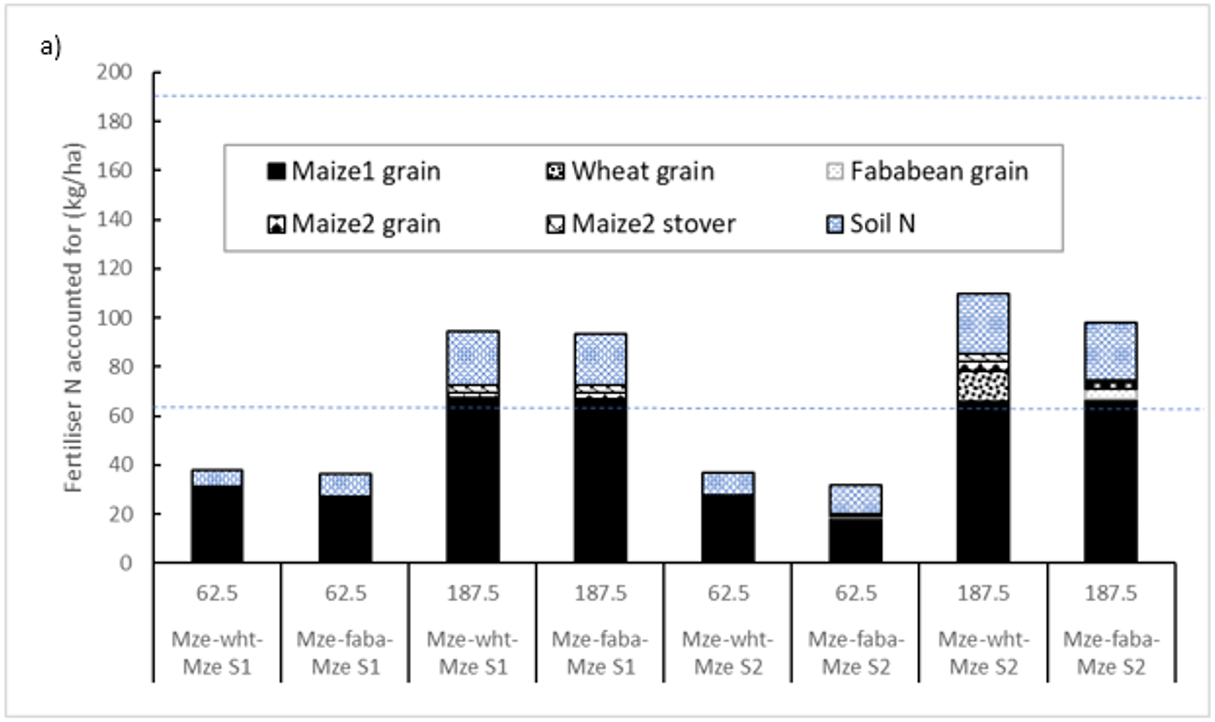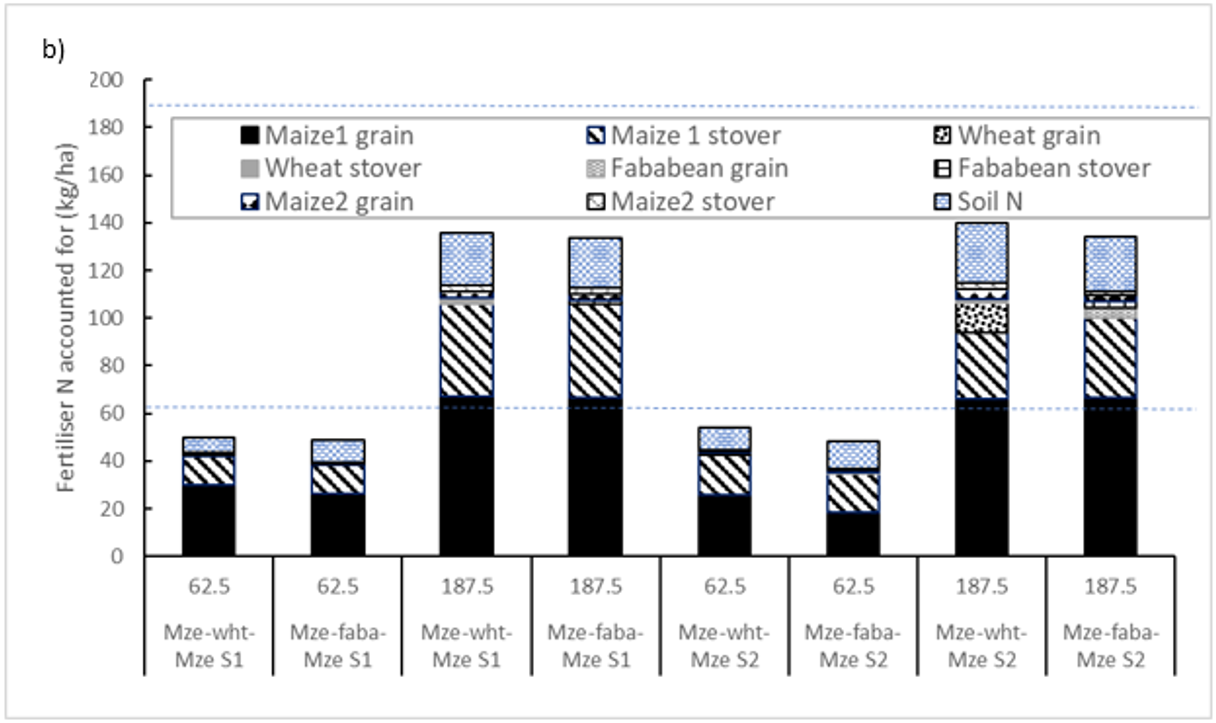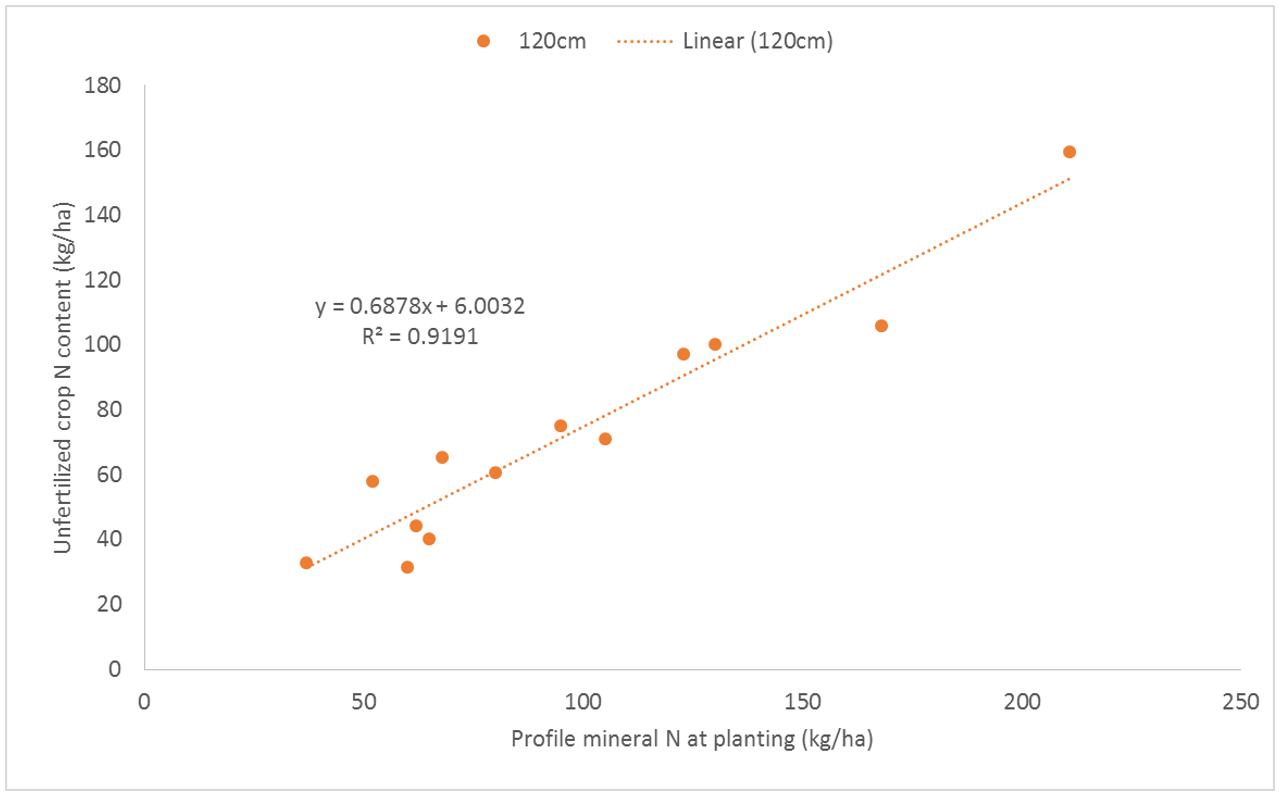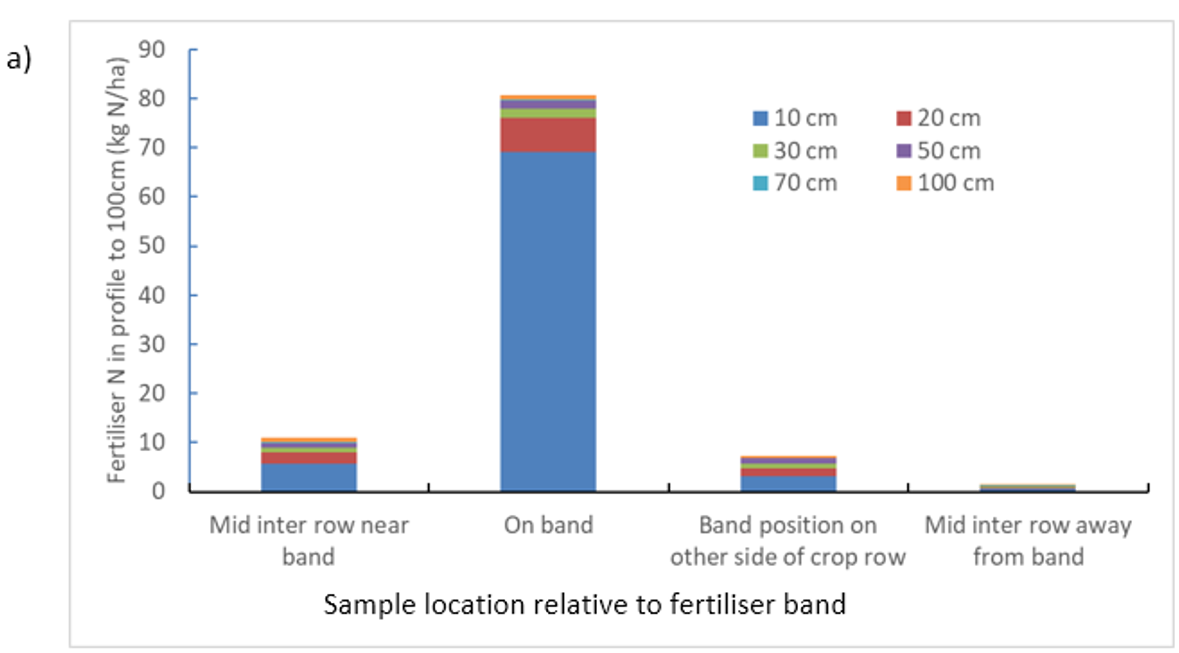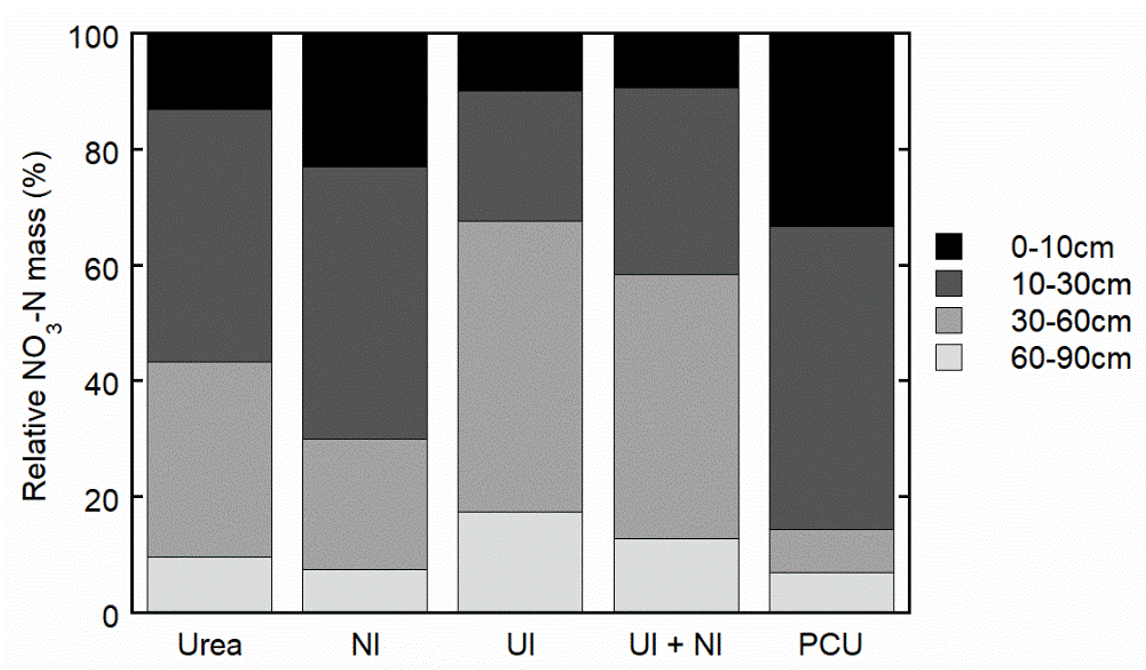Off-site losses and nitrogen use efficiency – swings and roundabouts and the potential impact of stabilised fertilisers on nitrogen recovery in northern production systems
Off-site losses and nitrogen use efficiency – swings and roundabouts and the potential impact of stabilised fertilisers on nitrogen recovery in northern production systems
Author: Mike Bell (UQ), Peter Grace (QUT) | Date: 06 Mar 2024
Take home message
- Declining soil organic matter and low legume frequencies in crop rotations increase the reliance on fertiliser-derived nitrogen (N) in the northern region, with variable seasonal rainfall limiting opportunities for in-season fertiliser N applications
- Co-location of water and available N within the soil profile is a requirement for efficient recovery and use of N, with fertiliser applications late in the fallow or at planting limiting the chances for efficient N recovery in the season of N application
- From a productivity perspective, N fertiliser practices need to focus more on ensuring reserves of mineral N are available through the soil profile, rather than trying to finesse N rates for the coming season based on likely yield potential
- Such strategies can potentially increase the periodic loss of N due to denitrification in wet seasonal conditions, but a better understanding of that loss pathway and the conditions under which large losses occur are needed so these risks can be quantified
- Stabilised fertilisers reduce the risk of N2O loss during the growing season but can also limit fertiliser N uptake by restricting nitrate leaching and increasing positional unavailability in dry topsoils. Their impact on N use efficiency is therefore uncertain.
- The efficiency of use of residual fertiliser N in subsequent crop seasons is under active exploration in current research activities.
Background
The northern grains region has unique characteristics that represent both strengths and weaknesses in terms of the efficient use of fertiliser nitrogen (N) to produce food and fibre. These can be summarised as follows –
Strengths
- Alkaline clay soils with moderate to high plant available water capacity (PAWC) that can buffer highly variable in-crop rainfall, providing a guide to the ‘minimum’ likely seasonal yield targets based on stored soil water at sowing. Seasonal forecasts or estimates of in crop rainfall can then be used in a risk-based approach to increase these yield targets and guide management decisions (plant configurations, fertiliser rates etc).
- Moderate background soil fertility in most situations, depending on cropping duration, with relatively simple combinations of nitrogen (N), phosphorus (P), and in some cases potassium (K), usually able to optimise grain yields and water use efficiency.
- A well understood minimum/zero tillage management system that can efficiently store water during fallows between cropping opportunities, while minimizing erosion risk.
- Soils that minimise the leaching of mobile nutrients like N below the depth of the crop root zone, with a low risk of contamination of groundwater or riverine ecosystems.
Weaknesses
- A substantial decline in soil fertility reserves due to an extended period of negative nutrient budgets (i.e. nutrient removal > nutrient replacement). This rundown has occurred due to a combination of relatively high starting fertility and the financial risks associated with high input costs for uncertain crop returns in a risky production environment.
- Declining soil organic matter (SOM) and microbial activity associated with continuous cropping, limited use of green/brown manures and the use of extended fallows to allow recharge of soil profile water content.
- Rotations dominated by grain and oilseed crops, with a low frequency of legume species grown for grain or cover cropping.
- Increasing evidence of depletion of subsoil nutrient reserves (especially for immobile nutrients like P and K), due to the strong reliance on deeper layers to supply water and nutrients during periods between sporadic rainfall events.
- Slow rates of water infiltration, especially once topsoil layers are wet, with implications for the rate of replenishment of nitrate-N in deeper profile layers after high yielding crops and/or large loss events.
The combination of these strengths and weaknesses is contributing to increasing complexity of nutrient management decisions that require careful consideration, and flexible approaches that consider the site and seasonal conditions under which fertiliser N is being applied.
Swings and roundabouts of fertiliser NUE
Seasonal rainfall (both amount and distribution), the resulting crop root distribution, and the extent to which crops are reliant on fresh fertiliser inputs to meet crop demands, collectively have a large impact on the efficiency of nutrient recovery by crops. While these risks are exacerbated for nutrients like P and K that are not leached into deeper soil layers as profiles refill, similar risks of poor N recovery efficiency (and off-site losses) also exist due to strategies that see N applied into relatively wet soil profiles late in the fallow. This strategy limits the opportunity for applied N to move into deeper profile layers, where it can remain available for plant uptake during drier seasonal conditions. As the rates of N mineralisation from SOM and crop residues during the fallows between crop cycles decline, subsoil N replenishment is becoming increasingly reliant on residual fertiliser N that has carried over from previous seasons and mineralisation of N from crop residues over the fallow that have collectively been leached into deeper profile layers as soil water recharge occurs. There is lots of evidence for accumulation of nitrate-N in soil profiles during drier growing seasons (examples from Colonsay and the GRDC farming systems trial network in recent GRDC Updates), but there is limited data that quantifies the efficiency of residual fertiliser N recovery across multiple crop seasons. Research conducted under NANORP (the National Nitrous Oxide Research Program – 2012-2015) used 15N to quantify fertiliser N recovery for single season sorghum crops from 2012/13 to 2014/15 (Rowlings et al., 2022), with average fertiliser N recovery in crop biomass of 37–40% on Vertosols and a much higher 65% on Ferrosols (Figure 1). Fertiliser N removal in harvested grain averaged two thirds of the N uptake in biomass (26–30% on Vertosols and 44% on Ferrosols), but the fate of fertiliser N returned in residue or left in the soil at harvest (an average of 35-45% on the Vertosols and 33% on the Ferrosols) was not able to be determined. Fertiliser N losses in that first season, presumably due to denitrification, averaged 26–30% on Vertosols and 22% on Ferrosols.
The examples provided in Rowlings et al., (2022) indicate the relatively poor crop uptake of freshly applied fertiliser N bands, particularly in Vertosols, with only approximately 40% of fertiliser taken up by the crop and only 30–35% of fertiliser N removed from the field in grain. With 20–30% of applied N lost to the environment, 35–45% of applied N is either retained in the soil or returned in residues. Particularly where the crop failed to perform in a dry season (e.g. Bongeen site) and/or where high rates of N application have been used, this ‘carried over’ fertiliser N can be considerable (Figure 2) and the efficiency with which that ‘carry-over’ is retained over the fallow and subsequently recovered by following crops will be a critical factor in determining fertiliser NUE in these systems. Most of this carry-over fertiliser N is in the soil, in either organic or inorganic pools.
Figure 1. The fate of banded fertiliser N applied at rates of 40-160 kg N/ha at/before sowing for sorghum crops grown on Vertosol or Ferrosol soils from 2012 to 2015 (derived from Rowlings et al., 2022). The dashed lines represent average crop N recovery across N rates sites on Vertosols in commercial fields (Kupunn, Irongate F1 and F2) and on research stations on Vertosols (Kingsthorpe) and Ferrosols (Kingaroy). The Bongeen site (exceptionally dry conditions) was not included in the Vertosol averages.
While the carry-over of fertiliser-derived N into subsequent cropping seasons was not able to be determined in the NANORP studies, the fertiliser N carry-over into subsequent winter and summer crop seasons in a high intensity, double-crop system at Gatton was quantified by Manandhar (2023) over consecutive 18 month cropping periods. The results of a mass balance analysis on these sequences (maize-wheat/fababean-maize) are shown in Figure 3 below, with Figure 3a indicating fertiliser removed in grain, present in standing stubble or in the soil profile after the final maize crop, and Figure 3b showing the same data but including fertiliser N returned to the soil surface as residues from the initial maize and winter crops with unquantified rates of N mineralisation during the second maize crop. The difference between the recovered fertiliser N (stacked bars) and the dashed blue lines indicating the application rates of 62.5 and 187.5 kg N/ha represents fertiliser N that cannot be accounted for. The larger ‘missing’ N indicated in Figure 3a is due to the failure to include any of the fertiliser N in residues from the 1st maize crop and the winter crops, with this calculation assuming that this residue N was already in the soil N pool, taken up in the final maize crop, or lost off site. This is likely to over-estimate N losses, as unquantified proportions of those residues were still on the soil surface at harvest of the second maize crop. The smaller ‘missing’ N fraction in Figure 3b is a likely under-estimate of fertiliser N losses, as those stacked bar graphs assume that none of the fertiliser N in surface residues from the initial maize and following winter crops was mineralised and taken up by the final maize crop (or lost to the environment). The reality will be somewhere in between these two scenarios, but the key points to take from this study are that: (i) while residual fertiliser N could contribute to subsequent crops in the rotation, the overwhelming majority of crop uptake and grain N removal was in the initial maize crop to which the fertiliser had been applied; and (ii) the apparent losses of fertiliser N ranged from as little as 20–30% of applied N assuming complete preservation of all residue N (Figure 3b), to as much as 40–50% if surface residues were assumed to have completely mineralised (Figure 3a).
Figure 2. The amount of residual fertiliser N left in the soil mineral N pool and in crop residues after sorghum grain harvest that will potentially carry over for a subsequent cropping season. Crops had received N fertiliser at rates of 40-160 kg N/ha prior to sowing, with data derived from Rowlings et al., (2022).
Clearly, a better understanding of the fate of fertiliser N, particularly as it cycles through the soil and crop residue pools, is required in order to optimise the efficiency of fertiliser N use in our cropping systems. An additional 15 sites across the country are currently being used to quantify the residual effects of fertiliser N for subsequent winter and summer crops as part of UOQ2204 – 010RTX, with 15N-labelled fertilisers again being used to track N cycling and recovery over time.
Figure 3. Fertiliser N applied to an initial maize crop (Maize 1) and able to be accounted for in harvested grain, crop residues and soil N pools in a second maize crop (Maize 2) that was harvested 18 months after the initial fertiliser applications. Crop sequences were maize-wheat/faba bean-maize, with sequences beginning with fertiliser applications in 2019 (S1) or 2020 (S2) summer seasons. The dashed lines represent the urea-N application rates (62.5 or 187.5 kg N/ha). Data from Manandhar 2023.
Why is fertiliser N recovery in the year of application relatively poor?
Mineral N that is distributed throughout the effective rooting zone and co-located with soil water is generally recovered quite efficiently by subsequent crops. Data from 13 site-years in which grain sorghum was grown in commercial fields over three seasons (i.e., 2012 – 2015) with varying rates of N fertiliser applied prior to sowing is available from the GRDC project UQ00066 (Bell et al., unpublished data). The crop N uptake in the unfertilised treatments at each site was related to the summed profile mineral N to 120cm determined at sowing (Figure 4), with the relationship suggesting that crops recovered almost 70% of the available N across those three growing seasons. This mineral N recovery in crop biomass effectively doubles that recorded for fertiliser N applied at/near sowing in Figure 2 in the same growing seasons – albeit at different sites.
Figure 4. Biomass N content of unfertilised sorghum crops grown with varying amounts of mineral N in the top 120cm of soil profile at sowing. The slope of the linear relationship represents the efficiency of crop recovery of mineral N distributed within the soil profile.
The key to improved N recovery efficiency lies in the volume of soil with available N that is accessible to crops during the uptake period, with accessibility determined by co-location of N with soil moisture. While P and K can move only limited distances in clay soils, with diffusive supply to plant roots requiring a high root density as well as moist soil for uptake, the situation is simpler for N, with primarily passive N uptake as the crop extracts soil water and dissolved N from that soil layer. There is no requirement for high root densities to achieve effective N uptake from a given soil layer, with water and N able to move to the roots to replenish crop uptake.
The fact that most fertiliser N in the northern region has been applied in subsurface bands, with those bands often widely spaced and quite concentrated, has been shown to slow the redistribution of freshly applied fertiliser N within the soil profile. This is the result of (i) chemical reactions within the urea band that slow the conversion of (immobile) NH4+ to (mobile) NO3- (e.g. Janke et al., 2020; Martinez et al., 2022); and (ii) the application of fertiliser once the soil moisture profile is largely full, close to crop sowing, which limits the leaching of fertiliser N into deeper soil layers. As Janke et al., (2020) showed, the urea band could retain quite high concentrations of (immobile) NH4-N for >60 days after fertiliser application, which limited the volume of soil N enrichment, and ensured that crop access to that N was contingent on the soil layer within which the bands were placed remaining wet to allow water and N uptake throughout the growing season. This rarely occurs, and as illustrated in Figure 5 for (a) sorghum crop grown at Kingsthorpe (Rowlings et al., 2022) and (b) an irrigated maize crop grown at Gatton (Dang et al., 2021), often results in significant proportions of residual fertiliser N being found in/near the band position in dry soil in the top 10–20cm of the soil profile after crop harvest.
Figure 5. The distribution of residual fertiliser N with depth and proximity to the band position in Vertosols after (a) a sorghum crop grown at Kingsthorpe (Rowlings et al., 2022) and (b) an irrigated maize crop grown at Gatton (Dang et al., 2021). In both experiments, crop rows (and fertiliser bands) were 75cm apart and N was applied prior to crop sowing.
This heterogeneously distributed residual N from banded applications has to redistribute deeper into the soil profile during a subsequent fallow in order to achieve something like the efficiency of recovery seen from a distributed profile N in Figure 4. While that is happening, this residual mineral N (primarily as NO3-N) is vulnerable to potential loss processes (e.g. denitrification during wet conditions) and makes soil sampling to determine the fertiliser N rate for the next crop challenging. This N redistribution can take considerable time, as illustrated by the Northern Grower Alliance (NGA) data from sites monitored over 3–5 years (Daniel et al., 2019), but when considered over a number of ‘average’ seasons, profile N can be continuously replenished and system NUE can be enhanced. The challenge is the occurrence of seasonal conditions that do not allow profile mineral N accumulation and carryover (e.g. a series of high yielding crops that deplete profile N, and/or large N loss events during wet seasons), which can result in crops being highly reliant on fresh fertiliser applications without backup from distributed N down the profile. The fluctuating seasonal conditions seen from the N accumulation during the dry seasons from 2016 to 2019, followed by the wetter seasons from 2020 to 2023, are a good example of the N swings and roundabouts that can occur in our cropping systems.
Options for improving fertiliser NUE in northern systems
Management options that offer potential to smooth out these seasonal fluctuations in crop N availability are currently being evaluated from a number of possible avenues. These include –
- Adopting a strategy of ‘feeding the soil’ rather than trying to finesse annual fertiliser rates to match an uncertain seasonal demand. This recognises that maintaining a bank of labile N in the soil profile, both in organic and inorganic forms, is important to achieve water limited yield potentials, and that any possible gains from trying to optimize N rates in any given season are likely to be negated by a combination of lower NUE of freshly applied fertiliser and the uncertainty of the seasonal yield potential predictions. This would look more like applying an ‘average’ fertiliser N rate each season and topping up with late/in crop applications in years of high yield potential. The uncertainties around this approach lie primarily in the efficiency of recovery and use of residual/unused fertiliser N from year to year and require a better understanding of the factors that determine the frequency and extent of denitrification events and the risks associated with building up a significant ‘bank’ of mineral N that could cause crop haying off or be subject to increased risk of N losses. These issues are currently being quantified in GRDC project UOQ2204 – 010RTX at sites in Gatton, Kingsthorpe, Tamworth and Wagga Wagga, as well as another eight sites in the southern and western grain growing regions.
- Avoiding use of concentrated N bands, to ensure more rapid redistribution of N with rainfall events. This could include either closer spaced, less concentrated fertiliser bands or a move to broadcast applications with or without subsequent incorporation by tillage. There have been few studies on crop responses to narrower N band spacings in our stored soil water systems on Vertosols, although there have been advantages reported from increasing band spacings and in-band N concentrations (mid-row banding) to both reduce the risk of fertiliser N loss and restrict early season access to N in winter rainfall systems in southern areas (Wagga Wagga and Victoria – Sandral et al., 2017; Wallace et al., 2018). A preliminary study at Gatton with urea N applications applied prior to maize sowing that ranged from spread and incorporated to bands at 37.5cm, 75cm and 150cm spacings was inconclusive in terms of crop N recovery.
Spread urea during the cropping season is commonly used in systems with more reliable rainfall distributions and, typically, less reliance on stored soil moisture accumulated during a fallow. In northern areas, most spreading is done during the fallow, relying on rainfall events to incorporate the fertiliser N into the soil profile. Schwenke et al., (2014) have shown that volatilisation loss risks are higher in fallow situations than in crop, but in most soils and situations the increased risk of N loss from surface spreading is relatively small. This conclusion was consistent with the findings of Daniel et al., (2019), who were not able to demonstrate any differences between spread urea or urea drilled into the soil in bands in terms of crop N recovery or grain yield. However, total N recovery in the two systems was unable to be determined due to the inability to differentiate between soil and fertiliser N, and soil sampling data suggested only slow redistribution of applied N down the soil profile over periods of 4 to 5 years. These results suggest that moving away from banded applications will not deliver large improvements in fertiliser NUE, possibly due to an increase in the interactions between applied fertilisers, crop residues and the soil microbial community. These interactions may negate the delays in N redistribution resulting from banded applications, with greater N immobilisation in topsoil layers slowing the leaching of N into deeper soil layers. The extent to which microbial interactions delay the leaching and redistribution of fertiliser N are being explored in a joint UQ-DAF project funded under the federal Soil Science Challenge initiative (Project H4T03F0: Understanding impacts of contrasting cropping systems on soil organic matter and the dynamics of soil water and nitrogen in rainfed cropping systems on vertosols in northeast Australia), using GRDC farming systems sites at Pampas and Mungindi. - Allowing more time for fertiliser N to redistribute within the soil profile to improve crop N recovery in the year of application. This can be achieved by applying a proportion of the fertiliser N when soils are dry early in the fallow period, to ensure the wetting front moves nitrate N into deeper soil layers as the profile refills. Research in the Soil Science Challenge project is investigating the risks and possible rewards from early N applications at Mungindi and Pampas farming systems sites, with variation in crop sequences (applying after cereals or legumes) and the profile water content at different times during the fallow used to explore these issues. The extent to which immobilisation of N may delay nitrate leaching early in the fallow (e.g., with high cereal stubble loads) and the relative denitrification risk of early application with differing amounts and distributions of moisture in the soil profile will be key considerations.
- Employing different fertiliser N products to control the rates of release and subsequent transformations of fertiliser N to improve crop recovery and reduce environmental losses. These products have been discussed in detail by Martinez et al., (2022), reporting on a series of experiments at Gatton with maize. This research suggested that when N fertiliser is banded, there was little evidence of either coated or stabilised N fertilisers producing improved fertiliser N recovery. This is hypothesised to be because these technologies slow the formation or release of NO3 into the soil solution, and so delay the movement of N into deeper soil layers that are accessible during drier periods. These effects are illustrated in data reproduced in Figure 6 from Dang et al., (2021), which shows shallower distributions of NO3-N at the end of the crop growing season in both the polymer coated urea (PCU) and nitrification inhibitor (NI) products. Interestingly, there were suggestions that N from urea coated with the urease inhibitor (UI) NBPT (in products like Green Urea NV®), with or without additional NI technology, seemed to leach as much as that from standard urea. Whilst there were clear advantages of using NI technology to reduce nitrous oxide (N2O) emissions in these maize systems (e.g. Dang et al., 2021), the higher costs/kg of applied N and the lack of clear improvements in crop N uptake suggest more compelling evidence will be needed before greater adoption of these products will be undertaken by industry.
- Using fluid fertilisers, particularly those which contain a proportion of N in the nitrate form, to achieve quicker redistribution into deeper soil layers. Few direct comparisons between fluid and granular formulations have been made due to the confounding results from the different products that are typically used (e.g., urea-ammonium-nitrate (UAN) liquids cf. urea granules), with use typically governed by convenience rather than performance. The relative risks and rewards from greater proportions of NO3-N present at the time of fertiliser application require further investigation, with different seasonal conditions and soil types likely to affect the impact of these formulation choices.
Figure 6. Distribution of residual fertiliser N after harvest of an irrigated maize crop at Gatton in which fertiliser N was applied as bands of urea or a variety of urea-based enhanced efficiency fertiliser products (Dang et al., 2021). PCU = polymer coated urea, NI = nitrification inhibitor, UI = urease inhibitor.
Acknowledgements
The research undertaken as part of this project is made possible by the significant contributions of growers through both trial cooperation and the support of the GRDC, the author would like to thank them for their continued support.
References and further reading
Bell MJ, Lester D, Sands D (2020) Nutritional strategies to support productive farming systems. GRDC Update paper.
Dang YP, Martinez C, Smith D, Rowlings D, Grace P and Bell M (2021) Maize production and nitrous oxide emissions from enhanced efficiency nitrogen fertilizers. Nutrient Cycling in Agroecosystems 121, 191 – 208.
Daniel R, Norton R, Mitchell A, Bailey L, Kilby D, Duric B and Price L (2019) 5 years of Nitrogen research – Have we got the system right? GRDC Update August 2019.
Janke CK, Moody P and Bell MJ (2020) Three-dimensional dynamics of nitrogen from banded enhanced efficiency fertilizers. Nutrient Cycling in Agroecosystems, 118: 227-247.
Manandhar S (2023) Quantifying fertilizer N and legume N recoveries in a no till maize-legume rotation using stable isotope techniques. PhD Thesis, University of Qld.
Martinez C, Janke C, Dang Y and Bell M (2022) Nitrogen release dynamics of enhanced efficiency fertilisers (EEFs): placement, soil factors and plant uptake. GRDC Update online.
Rowlings DW, Lester DW, Grace PR, Scheer C, de Rosa D, Migliorati MdeA, Friedl J, Bell MJ (2022) Seasonal rainfall distribution drives nitrogen use efficiency and losses in dryland summer sorghum. Field Crops Research 283.
Sandral G, Tavakkoli E, Harris F, Koetz E (2017) A test of nitrogen fertiliser use efficiency in wheat using mid row banding. GRDC Grains Research Updates.
Schwenke G, Manning W, Haigh B (2014) Ammonia volatilisation from nitrogen fertilisers surface-applied to bare fallows, wheat crops and perennial-grass-based pastures on Vertosols. Soil Research 52, 805-821
Wallace A, Nuttall J and Marsh J (2018). Refining nitrogen placement in cereals – mid row banding. GRDC Grains Research Updates Feb 2018.
Contact details
Mike Bell
University of Queensland
Gatton Campus
Ph: 0429 600 730
Email: m.bell4@uq.edu.au
Date published
March 2024
GRDC Project Code: UOQ2204-010RTX,



